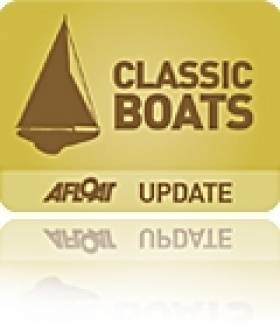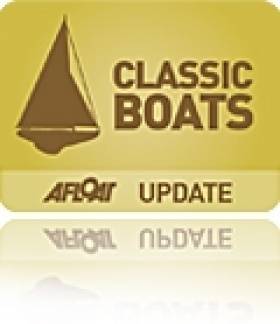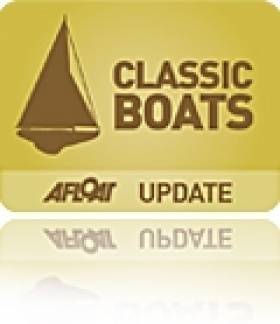Displaying items by tag: Historic Boats
Famous Ballycotton Lifeboat Saved Leaves Fate of Naom Éanna Open to Dáil Questions?
#FamousLifeboat – Former Ballycotton RNLB lifeboat, Mary Stanford, arguably the most famous vessel to serve the institution, is due to return 'home', following years of neglect in Dublin's Grand Canal Dock, leaving the fate of Naom Éanna much to be desired, writes Jehan Ashmore.
On Wednesday, Naom Éanna, the former Galway-Aran Islands ferry built by Liffey Dockyard in 1958 for the CIE operated service, was moved by Waterways Ireland on foot of safety concerns should the veteran vessel spring a leak and sink in the basin. Such a situation potentially poses health, safety risks not to mention a navigation obstacle that could hinder notably the Viking Splash Tours amphibious excursion craft entering the basin.
As for the Mary Stanford, her fate is finally secured after two decades in attempting to restore her, following the establishment of a committee that began in October 2013 which has successfully raised funds in acquiring the 51ft Barnett-class lifeboat.
In mid-March she is due to be transported by road to Ballycotton on Cork's southern coastline, where she made history in rescuing the crew of the Daunt lightship in 1936. The 60-hour ordeal that took place on 11 February, 78 years ago, would became the first and only lifeboat in RNLI history to have been awarded a gold medal for gallantry, that is for the boat herself, as well as her crew who were recognised for their bravery.
The Gold medal was awarded to Coxwain Patrick Sliney, a grandfather of Colm Sliney who is involved in the campaign to bring her home. The silver and bronze medals were also presented to the rest of the crew at a ceremony held in London and notably attended by Duke of Kent, who would later abdicate as King Edward VII. A photograph of the event depicts the Duke chatting to some of the lifeboat crew as published in the Cork Examiner of the time, see the Facebook page for Save the Mary Stanford.
On the return of Mary Stanford to Munster, the boat will be raised on a plinth near the entrance to the Ballycotton Cliff walk and may need to be covered during her restoration. The cruiser-stern boat has mahogany decks surrounding her superstructure constructed on a double-diagonal planked hull.
During her career between 1930 and 1959, she was called out on 41 'shouts' resulting in the saving of 122 lives. In order to carry out this second stage of the restoration project, further fundraising is required and the committee have also set up a website to the lifeboat that saved so many lives!
At one stage, the lifeboat beame a pilot cutter for Limerick Harbour Commissioners before eventually ending up in the Grand Canal Basin, from where until recently she was moored alongside Naom Éanna. Noting, this is how her name is spelt (as to distinct to Naomh with a 'h'), and port of registry, Gallim, using Gaelic traditional script which can be barely be seen when viewed from the basin as the stern of the vessel remains exposed in the graving dock.
Vandals Damage Dover's Bronze Age Boat
#BronzeAgeBoat - Dover's replica Bronze Age boat has been moved to a secure location after being vandalised, according to Kent Online.
It's reported that a tent covering the vessel on the port town's Roman Lawn was damaged, and saw marks were made on one side.
The incident comes just days ahead of the launch of a campaign to fund works on the historic boat - a half-size replica of one built some 3,500 years ago - to make it seaworthy after it sank in the Dover docks last year.
A similar project in Cornwall saw the fruit of its own restoration work this past March, when their 50ft Bronze Age boat was set afloat in Falmouth.
As previously reported on Afloat.ie, the Cornish boat is crafted from two giant oak logs and using tools similar to what boat builders of the time world have used in the post-Neolithic era.
#ClassicShip – It won't be all about vessels under sail as the veteran T.S.M.V. Cill Airne, which served as a trans-Atlantic passenger liner tender in Cobh, will be open to the public as part of the inaugural Dublin Port River Festival (1-3 June), writes Jehan Ashmore.
Throughout the three-day festival, the Cill Airne will have an Open Day between 11am to 6pm.
Since 2006, the Cill Airne has been moored as a static restaurant and bar venue along Dublin's North Wall Quay.
As previously reported on Afloat.ie, last year she celebrated a major milestone, having been built 50 years ago at the nearby old Liffey Dockyard.
To celebrate her half-century, the Irish branch of the World Ship Society (WSS) based in Cobh held a special luncheon on board in the beautiful timber surroundings of the Quay 16 Restaurant.
The 500 tonnes vessel is also unique in that she is the last ship built from the yard.
Research has indicated that she along with her sister Blarna were built with rivetted hulls, this was a political one, designed to ensure employment of the last riveting crews at the dockyard.
This made Cill Airne unique to Dublin's maritime industrial heritage but also significant in that this outdated shipbuilding technique was still in practise in a European shipyard.
Why not come on board during the festival and explore this rare example of a surviving Irish built vessel.
In addition the upper decks will provide an opportunity to gain a higher elevation of the myriad of boating traffic and with Tallships berthed either side along the quays.
On Saturday the Howth 17's, the world's oldest one-design keelboat class still racing will indeed be doing just that!...and on Sunday the Old Gaffers 'Parade of Sail'.































































